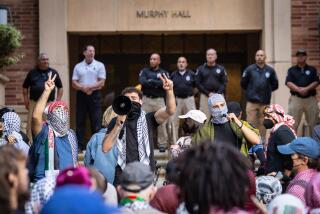Peace Officer
- Share via
Tears well up in the 15-year-old runaway’s sullen eyes as her black-painted fingernails nervously pick at a nose stud embedded in red, swollen flesh. She crosses her arms resolutely and shoots a death glare across the cramped room at Glendale Police Officer Marilyn Cisneros.
The girl may be a typical runaway, but Cisneros is no typical officer. She knows the girl’s mother, who reported her missing the day before. She knows who the girl’s friends are. And she knows that the girl and her mother are not getting along.
“That’s a new nose ring, isn’t it? Did you and your mom fight about that? Are things OK at home? Why don’t you want to go home? I know your mom and she’s a nice person. She doesn’t deserve this.”
Cisneros knows these things because she works out of an office at Glendale’s Hoover High, not a police station or a patrol car. She wears a department-issued polo shirt and jeans instead of a uniform.
She is a school resource officer, one of hundreds nationwide assigned by police departments to work full time at neighborhood schools. The Glendale Police Department’s program, created in 1968, is one of California’s oldest.
To watch Cisneros is to appreciate why such officers are viewed as crucial to keeping a fragile peace on increasingly volatile campuses.
She has a complex role of both enforcer and counselor, authority and friend. She banters with laughing students and moments later faces down a would-be brawler with her athletic 5-foot-10 frame and stern words. A youthful 31 in sneakers and Ray-Ban sunglasses, she blends in, but her gun is always visible.
For 15 minutes this morning, Cisneros has questioned the uncooperative runaway, receiving nothing but glares. Now the officer sighs and gets up out of her chair. She is convinced that the girl, who keeps several changes of clothing in her backpack, will run away before her mother arrives at school. She decides to detain her at the station.
“Stand up. Put your hands on your head,” she says. Within minutes, the girl is handcuffed, searched and marched to the front of the school and into a police car.
Cisneros goes back to her rounds on campus, catching numerous students littering and checking the girls’ restrooms for furtive smokers. Later in the day, she tries to persuade a badly bruised boy to identify the gang members who had beaten him with sticks.
She is looking for small signs of trouble. What street cops might dismiss as a minor incident--running away, a fistfight--can be enough to disrupt learning, create another high school dropout or lead to a fatal encounter outside the gates.
“I just want these kids to stay in school,” Cisneros says. “And they won’t if they don’t feel safe here or if they think nobody cares what they do.”
More than half of Los Angeles County’s 81 school districts have some sort of police presence on high school and junior high campuses, says Bill Ybarra, consultant for the Los Angeles County Office of Education’s Safe School Center.
The Los Angeles Unified School District has had its own school police force for nearly three decades, but most smaller districts have to depend on their community police departments.
Like so many other cities statewide, Glendale’s high school enrollments have swelled well above capacity, leaving the Police Department scrambling for ways to beef up campus police presence within its budget. When Glendale Police Chief James Anthony gets his share of new state funds allocated for local law enforcement, he may add an officer to each of Glendale’s two high school campuses.
At the end of a long workday, Cisneros drives her unmarked car down a busy Glendale street. Her day concluded with the arrest of the gang member who had beaten the boy with sticks.
“I have a love-hate relationship with these kids. I arrested some of them when I was doing [gang] task force and a lot of them are still hanging around me at school because they like the attention. The kids aren’t that bad, really. They’re just being kids.”
Cisneros harbors no illusions about what happens after the last bell rings. Peer pressure, gangs and troubled home lives can undermine her best efforts.
Now, as she heads home, the runaway she detained earlier that day stands a half a block away with her mother at the crosswalk, a stony silence between them as they look in opposite directions.
More to Read
Sign up for Essential California
The most important California stories and recommendations in your inbox every morning.
You may occasionally receive promotional content from the Los Angeles Times.










